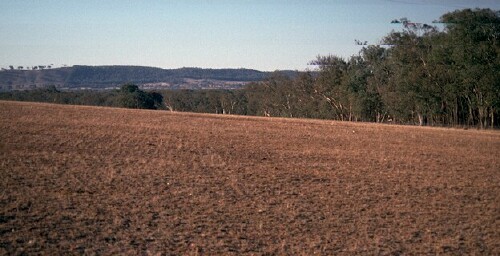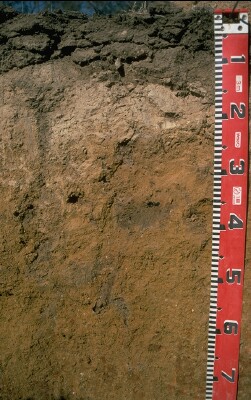NE3
| Group: Chiltern Landcare Group | Australian Soil Classification: Bleached, Dystrophic, Yellow KUROSOL |
| Northcote Factual Key: Dy 2.41 | Great Soil Group: yellow podzolic |
 NE3 landscape |
Soil Profile Morphology:
Surface Soil
| A1 | 0-5 cm | Dark brown (10YR3/3); light sandy clay loam with a hardsetting surface condition; weak coarse blocky structure; firm consistence dry; contains a common (20%) amount of quartz gravel (2-5 mm); pH 5.3; sharp and wavy change to: |  NE3 profile |
| A2 | 5-25 cm | Yellowish brown (10YR5/6) conspicuously bleached (10YR8/4d); light sandy clay loam; massive; very firm consistence dry; contains a common (20%) amount of quartz gravel (2-5 mm); pH 5.1; abrupt and wavy change to: | |
| Subsoil | |||
| B21 | 25-50 cm | Brownish yellow (10YR6/8); light medium clay (sandy); massive; strong consistence dry; contains a few (10%) quartz gravels (2-5 mm); pH 4.9; gradual change to: | |
| B22 | 50-70 cm | Brownish yellow (10YR6/8); medium clay (sandy); moderate medium polyhedral structure; strong consistence dry; contains a common (15%) amount of quartz gravel; pH 4.8; gradual change to: | |
| B23 | 70-90 cm | Yellowish brown (10YR5/6) and red (2.5YR4/8); light medium clay (sandy); strong medium to fine polyhedral structure; strong consistence dry; contains a common (20%) amount of quartz gravels (2-5%); pH 5.0; gradual change to: | |
| B24 | 90+ cm | Light brownish grey (10YR6/2) with red (2.5YR4/8) and brownish yellow (10YR6/8) bands; light medium clay (sandy); strong medium to fine polyhedral structure; strong consistence dry; contains many (25%) quartz gravels (2-5 mm); pH 4.8. | |
Key Profile Features:
- Strong texture contrast between the surface (A) horizons and clay (B) horizons.
- Conspicuously bleached subsurface A2 horizon.
- Soil pH (water) is < 5.5 throughout the profile.
Soil Profile Characteristics:
Horizon | pH | Salinity Rating | ||
Surface (A1 horizon) | strongly acid | very low | non-sodic | water-stable |
Subsoil (B21 horizon) | very strongly acid | very low | non-sodic | slaking, no dispersion |
Deeper subsoil (at 1 m) | very strongly acid | very low | non-sodic | slaking, no dispersion |

Horizon | Horizon Depth (cm) | pH (water) | pH (CaCl2) | EC 1:5 | Exchangeable Cations | |||
Ca | Mg | K | Na | |||||
meq/100g | ||||||||
A1 | 0-5 | 5.3 (5.2) | 4.3 | 0.06 | 5 | 0.8 | 0.2 | <0.1 |
A2 | 5-25 | 5.1 (4.9) | 4.0 | <0.05 | 1.1 | 0.3 | 0.1 | <0.1 |
B21 | 25-50 | 4.9 (4.9) | 4.1 | <0.05 | 1.2 | 1.2 | 0.2 | 0.1 |
B22 | 50-70 | 4.8 | <0.05 | 0.6 | 1.9 | 0.3 | 0.1 | |
B23 | 70-90 | 5 | <0.05 | 0.4 | 2.4 | 0.4 | 0.1 | |
B24 | 90+ | 4.8 | <0.05 | 0.2 | 2.4 | 0.4 | 0.1 | |
Horizon | Horizon Depth (cm) | Exchangeable Aluminium mg/kg | Field Capacity pF 2.5 | Wilting Point pF 4.2 | Coarse Sand (0.2-2.0 mm) | Fine Sand (0.02-0.2 mm) | Silt (0.002-0.02 mm) | Clay (<0.002 mm) |
A1 | 0-5 | 56 | 26.2 | 14.1 | 23 | 35 | 17 | 16 |
A2 | 5-25 | 132 | 17.9 | 10 | 24 | 39 | 17 | 19 |
B21 | 25-50 | 242 | 27.5 | 19.5 | 15 | 18 | 9 | 57 |
B22 | 50-70 | 244 | 31.9 | 24.2 | 12 | 11 | 8 | 68 |
B23 | 70-90 | 239 | ||||||
B24 | 90+ | 236 |
Management Considerations:
Surface (A) Horizons
- The strongly acid surface soil indicates that aluminium and manganese toxicity may occur. The level of exchangeable aluminium measured in the laboratory (56 ug/g) suggests that highly sensitive species such as barley, lucerne, phalaris, medics and some wheat varieties may be effected. Raising the pH level of the surface soil will help reduce that toxicity. A lime test (sampled at the paddock level) may be appropriate to determine how much lime is needed to raise pH levels. Deficiencies in molybdenum, calcium and potassium may also occur. The level of exchangeable aluminium increases in the A2 horizon to a level (132 ug/g) which is likely to effect sensitive species such as canola and other wheat varieties as well as highly sensitive species.
- The overall nutrient status for the surface is low (in terms of the sum of the exchangeable basic cations). However, the total nitrogen and organic matter levels are high. The high organic matter is important for maintaining surface soil structure and minimising surface soil slaking. However, soils with high organic matter levels require larger quantities of lime to raise the pH. Surface soil organic matter is also important for improving soil fertility and water holding capacity.
- Subsurface (A2) horizon has a very low overall nutrient status (in terms of the sum of the exchangeable basic cations).
Subsoil (B) Horizons
- The subsoil is non-sodic and non-dispersive. Subsoil drainage is therefore likely to be reasonable.
- The subsoil is very strongly acid and exchangeable aluminium (240 ug/g) levels measured in the laboratory are high and will affect the growth of aluminium sensitive species and possibly even some aluminium tolerant species.
- The overall nutrient status in the subsoil is very low (in terms of the sum of the exchangeable cations).
Comments from Landholder:
- Superphosphate applied every year.
- Half a tonne of lime applied five years ago.
Notes
Profile described by Mark Imhof, Paul Rampant and Sonia Thompson (15/3/95)


